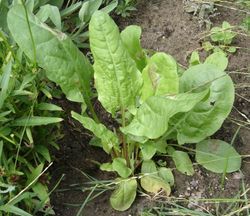Sorrel
- "Narrow-leaved sorrel" and variants redirect here. These terms may also refer to Curled Dock (R. crispus).
| Sorrel | |
|---|---|
 |
|
| Scientific classification | |
| Kingdom: | Plantae |
| Division: | Magnoliophyta |
| Class: | Magnoliopsida |
| Order: | Caryophyllales |
| Family: | Polygonaceae |
| Genus: | Rumex |
| Species: | R. acetosa |
| Binomial name | |
| Rumex acetosa L. |
|
| Synonyms | |
|
Rumex stenophyllus Ledeb. |
|
.jpg)
Common Sorrel or Garden Sorrel (Rumex acetosa), often simply called sorrel and also known as Spinach Dock or Narrow-leaved Dock, is a perennial herb that is cultivated as a garden herb or leaf vegetable (pot herb). Not the same as West Indian sorrel
Contents |
Growth
Sorrel is a slender plant about 60 cm high, with roots that run deep into the ground, as well as juicy stems and edible, oblong leaves. The lower leaves are 7 to 15 cm in length, slightly arrow-shaped at the base, with very long petioles. The upper ones are sessile, and frequently become crimson. The leaves are eaten by the larvae of several species of Lepidoptera (butterfly and moth) including the Blood-vein moth.
Characteristics
It has whorled spikes of reddish-green flowers, which bloom in summer, becoming purplish. The stamens and pistils are on different plants (dioecious); the ripe seeds are brown and shining.
Uses
Common sorrel has been cultivated for centuries. The leaves may be puréed in soups and sauces or added to salads and shav; they have a flavour that is similar to kiwifruit or sour wild strawberries. The plant's sharp taste is due to oxalic acid, which is a poison. In small quantities Sorrel is harmless; in large quantities it can be fatal[1].
In Northern Nigeria, sorrel is known as Yakuwa or Sure (pronounced suuray) in Hausa or Karassu in Kanuri. It is also used in stews usually in addition to spinach. In some Hausa communities, it is steamed and made into salad using Kuli-Kuli (traditional roasted peanut cakes with oil extracted), salt, pepper, onion and tomatoes. The recipe varies according to different levels of household income.
In Russia and Ukraine it is called shchavel' (щавель) and is used to make soup. It is used as a soup ingredient in other countries, too (e.g., Lithuania, it is called rūgštynė here). In Hungary this is known as soska [ pronounced Shoshka].It is called kuzu kulağı in Turkish. In Polish it is called szczaw. (pronounced shrtav)
In parts of Belgium it is served mixed with mashed potatoes, or as part of a traditional dish containing eel and other green herbs.
Subspecies
Several subspecies have been named; not all are cultivated:
- Rumex acetosa ssp. acetosa
- Rumex acetosa ssp. ambiguus
- Rumex acetosa ssp. arifolius
- Rumex acetosa ssp. hibernicus
- Rumex acetosa ssp. hirtulus
- Rumex acetosa ssp. vinealis
See also
- Scurvy-grass Sorrel
- Wood Sorrel / Oxalis
- Sorrel soup
|
||||||||||||||||||||||||||||||||||||||||||
| This herb-related article is a stub. You can help Wikipedia by expanding it. |